1869 – Gustav Adolf Zimmer
Rev. Gustav Adolf Zimmer was born in the village of Kraschen, Kreis Guhrau (Guhrau County), Provinz Schlesien (the Province of Silesia), Königreich Preußen (the Kindom of Prussia) on December 22, 1869. Beginning in August 1866, the Kingdom of Prussia was the leading power in the Norddeutscher Bund (the North German Confederation) a military alliance of 22 states of northern Germany. From 1861 to 1888, Prussia was ruled by Wilhelm I, also known as Wilhelm the Great.
Kraschen, Kreis Guhrau, Provinz Schlesien, Königreich Preußen
Kraschen was located about 50 miles northwest of the German city of Breslau (now Wroclaw, Poland), which was the provincial capital of Schlesien. Today, Kraschen is the village of Chróścina in the administrative district of Gmina Góra, (Góra administative district) Powiat Górowski (Góra County), Województwo Dolnośląskie (Lower Silesian Voivodeship, or province) in southwestern Poland.
Schlesien or Silesia is a historical region of Central Europe located mostly in present-day Poland, with parts in the Czech Republic and Germany. Throughout its history, it had been under the control of medieval Poland, Bohemia, Austria, Prussia, and the modern state of Germany. Silesia became part of the Königreich Preußen (the Kindom of Prussia) in 1742. By the beginning of the twentieth century, it had an almost entirely German-speaking and ethnic German population. In 1945, Silesia was split between Poland and Germany.
Although some genealogies place Gustav’s birth in Lower Silesia, that is not entirely accurate. In 1869, there was a single Prussian province of Silesia. It wasn’t until 1919, during the Weimar Republic, that Silesia was divided into the separate provinces of Upper Silesia (Oberschlesien) and Lower Silesia (Niederschlesien). Kraschen was then in Lower Silesia until about 1938 when the provinces were reunited. Today, as a part of Poland, Chróścina is in the Województwo Dolnośląskie (Lower Silesian Voivodeship).
parents and siblings
Gustav’s parents were Friedrich Wilhelm Zimmer (born April 6, 1834 in the town of Logischen; died March 8, 1916 in Ulbersdorf, Saxony), and Johannah Ernestine, whose maiden name is unknown (born February 13, 1846 in Logischen; died December 29, 1924 in Ulbersdorf).
Like Kraschen, Logischen in 1869 was also in Kreis Guhrau, Provinz Schlesien, Königreich Preußen, and was about two miles west of Kraschen. The local Lutheran parish was in Heinzendorf (today, Witoszyce), which lay on the road between these two villages. Today, Logischen is the village of Lagiszyn in Gmina Góra, Powiat Górowski (Góra County), Województwo Dolnośląskie (Lower Silesian Voivodeship).
Gustav was the second of four children born to Friedrich Wilhelm Zimmer. The eldest child, Paul Wilhelm Eberhard Zimmer, was born in 1865 to Friedrich’s first wife, Johanna Christiana Schumann, and according to family genealogy was born in the town of Bojanowa, Poland. (That spelling did not come up in a search, but a similar name—Bojanowo—was in Kreis Rawitsch, Provinz Posen, Königreich Preußen in 1865, and is in Poland today.) Bojanowo is 68 miles (110 km) northwest of Kraschen and Logischen.
Johanna Christiana died in 1867 when Paul was just two years old. On March 1, 1868, Friedrich married his cousin Johannah Ernestine Zimmer, who was born on September 5, 1845. They had three children: Gustav Adolf (1869), Bertha (1873), and Wilhelm Samuel (1877).
In 1869, the family lived in Kraschen, as indicated by Gustav’s birthplace. Bertha’s place of birth is unknown. The youngest child, Wilhelm, was born in Ulbersdorf, Saxony which places the family at that location by 1877. Gustav’s parents died in Ulbersdorf in 1916 and 1924.
This movement—from Bojanowo to Kraschen to Ulbersdorf—seems unusual for the mid-nineteenth century, especially at a time when the primary occupation was farming. Gustav’s father, Friedrich Wilhelm Zimmer, may have had a profession that occasioned movement. I had speculated that he may have been a pastor, especially since two of his children found church callings. However, his descendents have indicated that he was a miller and at least one has seen a photo of the Zimmers standing next to a flour mill.
G. A. Zimmer von Ulbersdorf
In 1877, Ulbersdorf was a tiny village in Königreich Sachsen (the Kingdom of Saxony) in the newly formed (1871) Deutsches Reich (German Empire). The German Empire was ruled by the Prussian king, Wilhelm I, but within the empire, Saxony was ruled by King Georg.
Today, Ulbersdorf is in the metropolitan district of Hohnstein in Freistaat Sachsen (Free State of Saxony), Germany, about 191 miles (308 km) west of Kraschen, Silesia. It lies southeast of Dresden, not far from the Czech border, and is in a region known as Sächsische Schweiz, or Saxon Switzerland, named for a mountainous area south of the town that has some 1,000 climbing peaks.
Gustav Adolf Zimmer was a prolific writer with at least fifteen books to his credit. Recent information shows that he wrote under the pen name G. A. Zimmer von Ulbersdorf, or simply Zimmer von Ulbersdorf. He was no older than nine when he moved to the town that became part of his identity. By adding the “von Ulbersdorf” to his name, it implied social status or nobility.
Before he emigrated to the United States, Gustav Zimmer’s last residence was the town of Limbach in Königreich Sachsen which lies 79 miles (127 km) to the west of Ulbersdorf. Today, Limbach is part of the town of Limbach-Oberfrohna in the district of Zwickau in the Freistaat Sachsen (Free State of Saxony). It is a northwest suburb of the manufacturing city of Chemnitz.
master baker
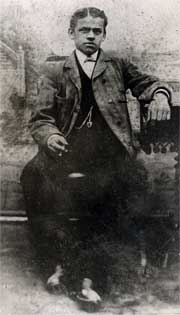
As a young man, Gustav served as an apprentice in bakery and confectionery shops and soon became a journeyman master baker. He worked in various European countries and spent substantial time in London, England.
By the time he was thirty, he had written three books on baking and allied arts. Two titles were listed in a 1917 bibliography of his writings:
- Der deutsche Feinbäcker (The German Fine Baker), 1896; 2nd edition, 1898
- Die deutsche Einmachekunst (The German Art of Preserving), 1899

A recently published children’s book, Der Bäcker Gustel: Erzählungen von Damals (The Baker Gustel: Tales of Yesteryear) is a compilation of five short stories by different German authors. The title 20-page story was written by Gustav Zimmer von Ulbersdorf. It is a tale of a fourteen-year-old boy named Gustel (a form of Gustav) and his mother Johanna who drive to the town of Freistadt in an oxcart. He is on his way to begin his apprenticeship to the Bäckermeister (master baker) Otto Fendler. For the next three years he won’t live with his parent or siblings but every fourteen days he will visit them and bring them delicious cakes and confectionaries. According to a grand-daughter, this story is an autobiographical slice of Gustav’s early life.
Der Bäcker Gustel was published in Germany in 2003 by Samenkorn e.Verein (Seedcorn Association), Liebigstrasse 8, 33803 Steinhagen, Germany. Samenkorn is a Christian volunteer organization that ministers to impoverished children in other countries, including Guatemala and Romania. Steinhagen is about four miles west of the town of Bielefeld, Westfalen. The book sells for €7.75 or about $11.00. The stories (all in German) include The Baker Gustel; Berta’s Temptation; Behold, I Stand at the Door; Too Late; and The Locust Beetle.
the Herrnhuter Bruedergemeine college in Niesky
At the same time that Gustav was apprenticing as a baker, he was drawn to a religious calling. He enrolled at the Moravian college in Niesky and began studies in preparation for missionary work. Today, Niesky is a small town in Kreis Görlitz at the eastern end of Freistaat Sachsen (the Free State of Saxony) in the Oberlausitz (Upper Lusatia) region just near the Czech border. When Gustav studied there, the town was part of Königreich Sachsen (the Kingdom of Saxony) in the Deutsches Reich (German Empire).
The town of Niesky was founded in 1742 by Bohemian immigrants from what is today the Czech Republic. As members of the Moravian Brethren church, they fled from persecution in their Catholic homeland. The Moravians are considered the first true Protestant church, founded by followers of reformer Ján Hus who was burned at the stake in 1415 in the town of Konstanz (Constance), situated on the Bodensee (Lake Constance) in southwest Germany near the Swiss border. The last words of Ján Hus as he was being tied to the stake were that, “In a hundred years, God will raise up a man whose calls for reform can not be suppressed.” Martin Luther’s Ninety-Five Thesis were written 102 years later in 1517.
In 1722, persecuted Hussites from Moravia and Bohemia were given refuge on an estate in Saxony owned by Count Nikolaus Ludwig von Zinzendorf (1700-1760), a wealthy Pietist. The Pietist movement in Germany emphasized personal piety and an emotional component to the religious life. This was in contrast to the state-sponsored Lutheran Church of the day, which had grown to symbolize a largely intellectual faith centered on belief in specific doctrines. Zinzendorf believed in “heart religion,” a personal salvation built on the individual’s spiritual relationship with Christ. He was extremely influential in the development of the theology of the Moravian Brotherhood.
The Moravian immigrants built the village of Herrenhut, or Herrnhut, on Zinzendorf’s estate in Kreis Görlitz, Königreich Sachsen. The new community became known as Herrnhuter Brüdergemeine (the Herrnhuter Community of Brothers). These Herrnhut Brethren later became known as the Moravian Brethren or the Moravian Brotherhood. They lived in close communities, sharing their resources with and supporting one another. They believed in suffering love and would not bear arms. But their most notable feature was that they promoted zealous mission work to other parts of the world.
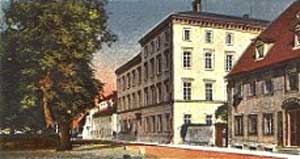
In 1869, the Herrnhut Brethren established a missionary training college at Niesky in Saxony. The candidates at the college were usually from Moravian communities, and many of them had previously attended the Kleinwelka school, a boarding school for children of missionaries who were serving around the world. The Niesky college training was less physically demanding than at some other German missionary training colleges. In 1890 it consisted of only five academic subjects (spelling, bible studies, bible history, church history, and general mission history), one language (five hours of English), gardening, singing, and an evening on Sunday School preparation. Afternoon classes were only held on three days, and Friday afternoons were devoted to a two-hour coffee meeting. This was a small school, enrolling perhaps 10 to 15 students each academic year.
The Herrnhuter school at Niesky provided training for candidates for the foreign mission field, but to become ordained, students often went on to a seminary in Gnadenfeld, Silesia. Gustav didn’t complete this final step of his training until he came to the United States. Gustav Zimmer most likely studied at Niesky for several years just prior to 1900.
According to his obituary, Gustav’s sister Bertha studied in Niesky as well. The Moravian church had established a deaconess training institute there in 1883. According to a grand-daughter, Bertha eventually became a deaconess in Jerusalem, and may have worked at Hansen’s Hospital, a leprosarium. She may have also worked at a hospital in Bir Zeit, near Ramallah.
emigration
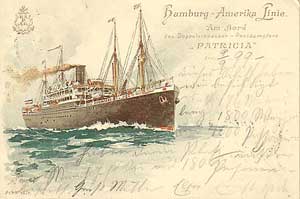
Gustav Adolf Zimmer left Germany on August 26, 1900 and arrived in the U.S. on September 7, 1900 at age 30. He sailed from Hamburg aboard the Patricia of the Hamburg-America Line and entered the United States at Ellis Island in New York.
His final destination was listed on the manifest as with an uncle, Henry Zimmer, at 143 Alexander Avenue in New York City. (I haven’t been able to find a brother to Gustav’s father named Henry in the family genealogy, but I have found a Henry Zimmer in New York.)
143 Alexander Avenue is in the Bronx, New York near the corner of 134th Street. The 1900 census shows a Henry Zimmer (born May 1854) and his wife Pauline (born March 1853) living at about that spot. They had a daughter Emma (18). Henry Zimmer (46) came to the U.S. in 1879 and was working as a “saloon keeper.”

On the ship’s manifest, Gustav’s occupation was listed as a “confectioner,” and above that was a note that said “baker.” He had $15 in his possession.
theological education
Gustav traveled to St. Louis, Missouri and enrolled at Eden Theological Seminary in nearby Wellston, Missouri.
Die Deutsche Evangelische Synode von Nord-Amerika
In 1900, Eden Theological Seminary was training pastors for Die Deutsche Evangelische Synode von Nord-Amerika (the German Evangelical Synod of North America) formed from a merger of several German Evangelical synods in the United States in 1872. The Synod had its roots in a pastors’ association formed in 1840 at Gravois Settlement (now Mehlville, Missouri) and just ten years later they established a seminary, the Evangelischen Predigerseminar (Evangelical Preacher’s Seminary) near the town of Marthasville, in Warren County. By 1866, this German Evangelical pastor’s association grew to become Die Deutsche Evangelishe Synode des Westens (the German Evangelical Synod of the West).
The various German Evangelical church bodies in North America traced their roots to Die Evangelische Kirche der Preußischen Union (the Evangelical Church of the Prussian Union) in Germany. It grew out of an early nineteenth century union between Lutheran and Reformed (Calvinistic) churches. In 1817, the Prussian king, Friedrich Wilhelm III, wanted a unified Protestant church and he issued a “Call to Union” to the two Protestant churches founded by Luther and Calvin. Part of his motivation was his grief that he had been unable to receive communion with his late wife because she was Lutheran and he was Reformed. In 1817, the Lutheran and Reformed traditions were united into one state church—Die Evangelische Kirche der Preußischen Union, or the Evangelical Church of the Prussian Union. Later this church was called Die Evangelische Kirche der Altpreußischen Union (the Evangelical Church of the Old Prussian Union).
The name Evangelical, which simply means “of the gospel,” was a political compromise between the two theological traditions. In the nineteenth century, the term Evangelical indicated a blending of Lutheran and Reformed traditions. In the United States however, the Evangelical churches were predominantly Lutheran in practice and custom.
Eden Seminary in Wellston, Missouri
Eden Seminary was located on the western outskirts of Saint Louis in the town of Wellston. It was originally known as the Evangelischen Predigerseminar (Evangelical Preacher’s Seminary), the school that had been established by the preacher’s association in the summer of 1850 in a rural valley four miles east of Marthasville, Missouri. The location was isolated, and in October 1883, the seminary moved to Wellston, where the students had better access to transportation, libraries, and many German Evangelical churches. (In 1924, another relocation brought the seminary to its present location in Webster Groves, Missouri.)
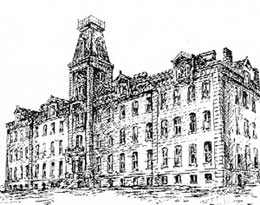
When Gustav Zimmer enrolled, Die College und der Theologischen Seminar der Deutschen Evangelischen Synode (the College and Theological Seminary of the German Evangelical Synod) was situated on 19 acres fronting on St. Charles Rock Road at the intersection of Lucas and Hunt Road. Eden Station, a stop on the Wabash, St. Louis and Pacific Railroad was nearby. A streetcar could travel from the Eden Station to downtown St. Louis in 30 minutes. The students spoke of making the trip to Eden, and the name began to apply to their school which was soon known as “the seminary at Eden.”
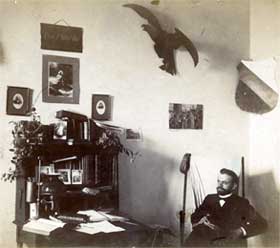
It was an ironic name for a place so rugged and austere. The men followed a rigid schedule of lectures, dictation, and manual labor. They were only allowed to leave the seminary on Saturday afternoons, and they were forbidden to go to the theater or a saloon or to have anything to do with women. All classes were in German. There was a gradual relaxation and modernization over the years. English was introduced in the 1890’s and students were allowed to become engaged in 1900. This was the year Gustav Zimmer arrived.
A grand-daughter said that Gustav attended Eden Seminary because his education would be paid for if he agreed to serve German Evangelical Synod parishes for some period of years after graduation.
Die Waisenblätter
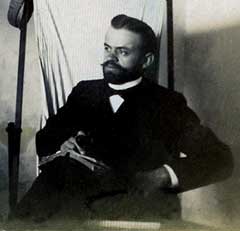
A 1917 Lexicon of German writers and storytellers, Kürschners Deutscher Literatur-Kalender, states that from 1901 to 1908, Gustav Zimmer was the founder and publisher of Die Waisenblätter, which translates as “The Orphan Pages.”
While attempting to discover the nature of this publication, I found a quote in a German publication from that period. It read: “Aus St. Louis in Nordamerika geht uns ein Probeheft der “Waisenblätter” aus der deutschen protest. Waisenheimat zu, die das Interesse aller deutschen Waisen häuser pflegen und die entlassenen Zöglinge mit ihrem Waisenhaus in lebendiger Fühlung halten wollen. Eine ansprechende Idee liebevoll ausgeführt.” Roughly translated it says: “From St. Louis in North America we have a sample issue of the Waisenblätter (Orphan Pages) from the German Protestant Orphans’ Home, which fosters the interest of all German orphanages and keeps alive the feelings of dismissed pupils with their orphanage. An appealing idea beautifully executed.”
Der Deutschen Protestantisch Waisenheimat
Der Deutschen Protestantisch Waisenheimat (the German Protestant Orphans’ Home) was a ministry of Deutsche Evangelische St. Petri Gemeinde (St. Peter’s Evangelical Church) in St. Louis, one of the two leading German congregations in the city. Founded in 1858, this facility eventually grew to a capacity of 290 children and accepted orphans of all creeds or nationalities. The current name is the Evangelical Children’s Home, located at 8240 St. Charles Rock Road in St. Louis, MO 63114 (314-427-3755).
Incorporated in 1861, the German Protestant Orphan’s Home operated in the parsonage at St. Peter’s Evangelical Church for the next two years. As more children arrived, these quarters became too small, so the orphanage moved to a larger home on Carr Street in downtown St. Louis. Following a fire in 1863, Rev. Nollau and the Board of Directors felt that the children needed a place in the country where they could breathe the clean air and learn a trade. They purchased a 65-acre farm on the St. Charles Rock Road for $23,500. The farm was on one of the highest points of St. Louis County and provided a substantial mansion, outbuildings, farming fields, as well as over 1,000 fruit bearing trees. In the fall of 1866, 60 boys and girls moved to the “country.” It was a half-day’s ride from the city by farm wagon.
The German Protestant Orphan’s Home continued to thrive. Every transaction, every communication was done in German. In 1900, the facility was on St. Charles Rock Road in Central Township, St. Louis County. The census recorded 285 children in the home.
It must have been at this location that Gustav Zimmer became involved with the ministry of the orphan’s home. I haven’t yet determined its proximity to Eden Seminary, which was also located on St. Charles Rock Road.
1868 – Anna Augusta Sagner
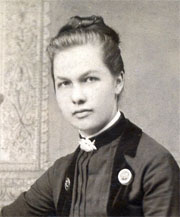
At some point while he was at the seminary, Gustav Zimmer met Anna Augusta Sagner.
Anna was born on November 26, 1868 in the small town of Meseritz located in Provinz Posen (the Province of Posen) in Königreich Prueßen (the kingdom of Prussia) to Johann August Sagner and Auguste Ernestine Kurtzhan. Today the town is in the Poznan region of Poland and is called Międzyrzecz.
Anna emigrated to America with her mother in 1885. A year earlier, her two older siblings (Gustav and Louisa) had preceded them to St. Louis. Her father, August, had arrived in 1869, separated from his wife and family for nearly 16 years.
dressmakers
Anna and her older sister Louisa were both dressmakers. The Gould’s St. Louis City Directory for 1893 listed “L & A Sagner Dry Goods” at 4203 Clay Avenue. Following that in the directory were individual listings for Louisa and her sister “Annie” Sagner with their company name and address (L & A Sagner Dry Goods, 4203 Clay Avenue) following their names. They apparently lived at the address where they operated their business. Unfortunately, the dry goods store did not last long. In 1895, the sisters were working at separate addresses. Gould’s St. Louis Directory for 1895 listed Louisa Sagner, a dressmaker, employed at 3040 Marcus Avenue in St. Louis.
marriage to pastors
Anna and Louisa Sagner both married pastors. On May 13, 1896, Louise Sagner married Rev. Johannes (John) A. Endter in Mount Eden, Alameda, California. Six years later, on August 13, 1902, Anna Augusta Sagner married Rev. Gustav Adolf Zimmer in Denver, Colorado. Both men had attended Eden Seminary. (See Johannes Endter and Louise Sagner)
In the 1900 census, Anna and her mother were living in the household of her brother Gustav Sagner at 4564 North Market in St. Louis. Their father, August Sagner had been buried the year before in Die Deutsche Evangelische Zions Friedhof (the German Evangelical Zion’s Cemetery) on St. Charles Rock Road which runs through the town of Wellston.
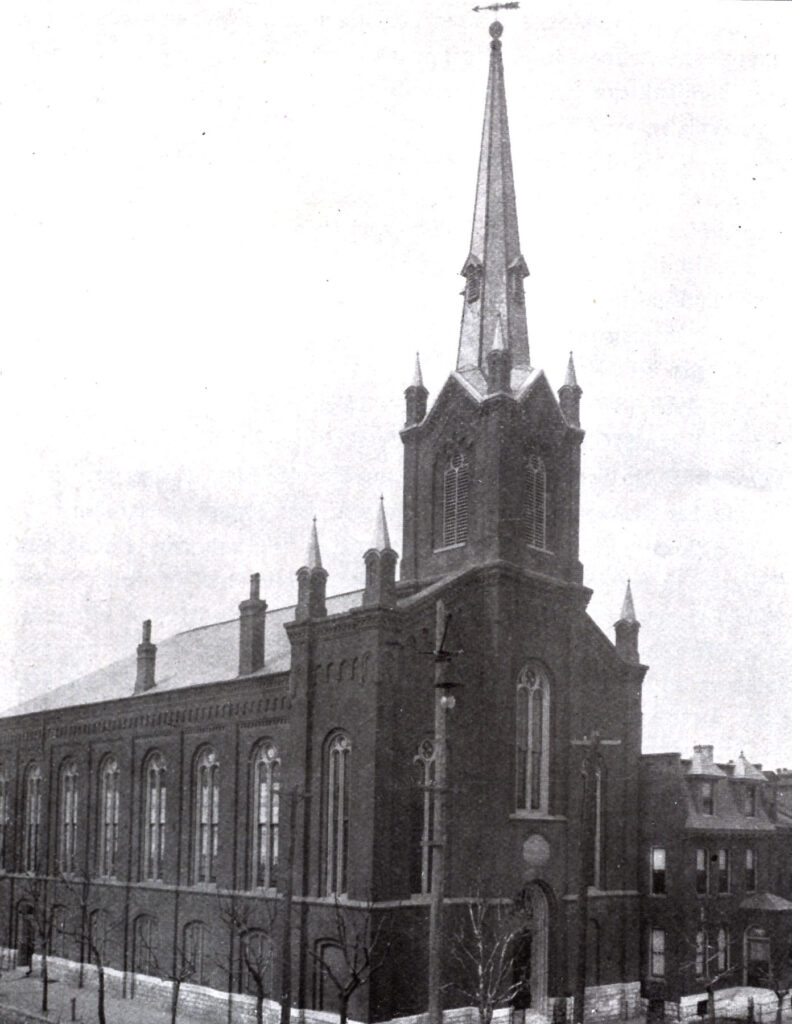
This leads me to speculate that the Sagner family may have belonged to Die Deutsche Evangelische Zions Gemeinde (the German Evangelical Zion Congregation), located in Old North St. Louis, an area just to the north of the downtown district. The congregation was founded in 1868 at 23rd & Montgomery streets. In 1872, it relocated to a new brick church at 2506 Benton at the corner of 25th street. (Today, the congregation is Zion United Church of Christ located at 5710 N. Hwy 67 in Florissant, Missouri.) The Zion cemetery was established in 1883 by the congregation. In 1887, the church was admitted to the Evangelical Synod of North America and in 1899, the church building was enlarged to meet the needs of a growing congregation.
The Sagner family lived about three miles west of the church. Eden Seminary in Wellston was another three to four miles west of the Sagner home. Since Zion was a German-speaking congregation of the Evangelical Synod, it is possible that Gustav Zimmer worshiped there or even preached there as a student.
marriage and children
Gustav graduated from Eden Theological Seminary in 1902. From what I’ve been able to translate from Gustav’s own German-language account of his work as a missionary in Utah, he was sent to Salt Lake City in June, 1902 as one of the first Protestant missionaries to the Mormon residents of Utah.
On August 13, 1902, Gustav Adolf Zimmer married Anna Augusta Sagner at the home of a Rev. Schmidt in Denver, Colorado. Anna and Gustav honeymooned in Utah and climbed Pike’s Peak.
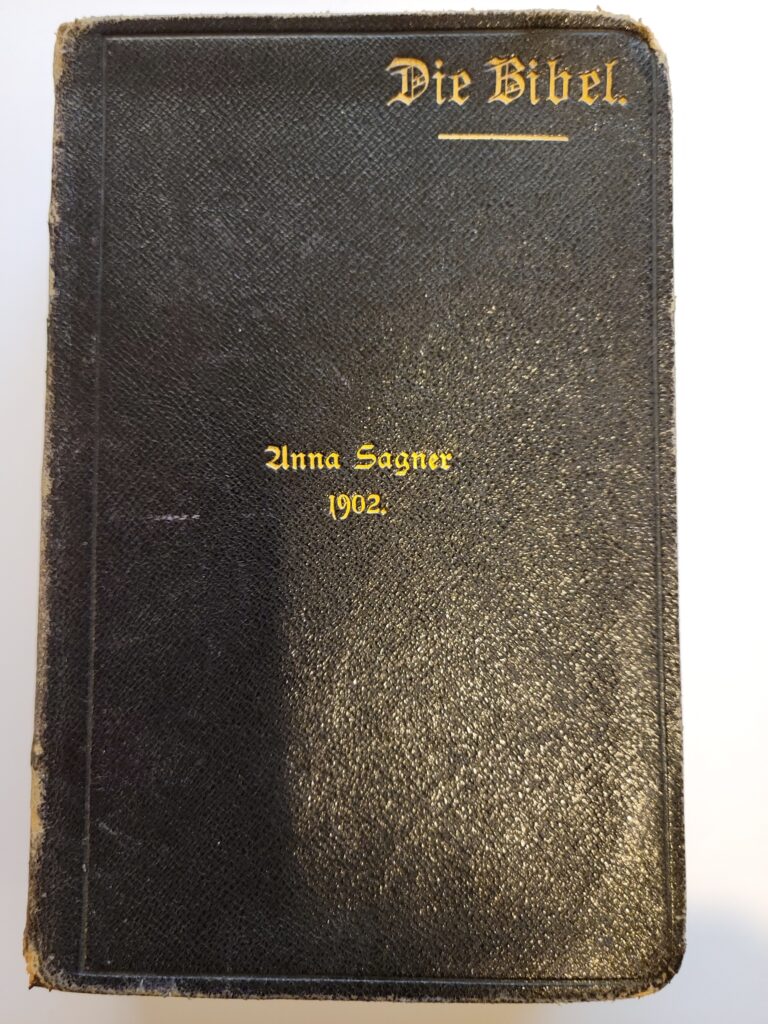
A bible was presented to Anna Sagner at the time of her marriage by the Young Women’s Society of the Evangelical Emmanuel Church. I don’t know whether this was her home church, which I thought was Zion, or Rev. Schmidt’s church in Denver.
However, subsequent searching revealed Emmanuel to be Immanuel United Church of Christ at 126 Church Street, Ferguson, Missouri 63135.
The city of Ferguson was founded in 1855, when William B. Ferguson deeded 10 acres (4.0 ha) of land to the Wabash Railroad in exchange for a new depot and naming rights. The settlement that sprang up around the depot was called Ferguson Station. Ferguson was the first railroad station connected directly to St. Louis. Ferguson, Missouri lies About six miles north of the city of Wellston.
The congregation purchased land from Mr. Ferguson for $350.00 for the first frame building of Evangelical Immanuel Church. The first pastor, Rev. Carl Struckmeyer, was installed on Dedication Sunday, June 3, 1888.
This was a surprise. It led me to research the background of Rev. Karl Christian Struckmeier as he kept popping up in stories of my family history.
Five children were born to Anna and Gustav Zimmer during their marriage:
- Johanna Ernestine Bertha Zimmer, born November 5, 1903 in Salt Lake City, Utah
- Bertha Elise Clara Zimmer, born August 19, 1905 in DeSoto, Missouri
- Lothar Paul Martin Zimmer, born October 30, 1908 in Bellefontaine, Missouri
- Dorothea Renata Zimmer, born November 6, 1909 in Cudahy, Wisconsin
- Dankwardt Samuel Wilhelm Zimmer, born October 29, 1911 in South Milwaukee, Wisconsin
mission in Utah
Johanna Zimmer’s birth in November 1903, clearly places Gustav and Anna in Salt Lake City, Utah by that time.
Gustav later recounted that, on January 18, 1903, he met with fourteen former Mormons to form a new congregation. On February 1, 1903, they incorporated under the name: Die Deutsche Evangelische Christus Gemeinde, the German Evangelical Christ Church.
Around the same time, in 1903 and 1904, Zimmer edited a publication called Das Licht von Utah (The Light of Utah).
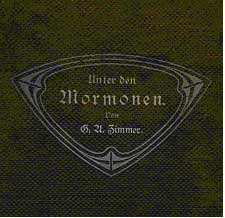
One of the most significant books by Zimmer von Ulbersdorf is called Unter den Mormonen in Utah: Mit besonderer Berucksichtigung der deutschen evangelischen Missionsarbeit, Ein Beitrag zur neuen Missionsgeschichte. It was published in 1908 by C. Bertelsmann in Gütersloh, Westfalen, Germany, and runs 130 pages with several photographs. The title translates as: Among the Mormons in Utah: With Special Reference to the German Evangelical Mission Work; a Contribution to Modern Mission History. It was written while he was living in De Soto and Bellefontaine, Missouri. The foreword was dated June 1907.
Among the Mormons was included in a 1909 bibliography of works relating to the Mormons compiled by the New York Public Library and a copy is in their collection. A first edition copy of this book is available from Ken Sanders Rare Books, www.kensandersbooks.com, for $250.
On June 18, 2008, Google digitized the book from the copy in the New York Public Library. Among the Mormons is available in a PDF version online.
Another related publication by Zimmer von Ulbersdorf is Im Schatten von Mormons Tempel: Erzählungen aus der Deutschen Evangelischen Mission in Utah. It translates as In the Shade of Mormons’ Temple: Narrations from the German Protestant Mission in Utah. At 112 pages, it was published in 1911 by Verlag der Buchhandlung des Erziehungsvereins at Neukirchen, Saxony, Germany.
Both of these titles reflect the two to three years he spent as a missionary in Utah.
A family story recounts that one evening in Salt Lake City, as Gustav was lighting a lamp on the parlor wall, a shot came through the window. It was clearly a warning. Soon after, he took his family to Missouri. I don’t know if the mission church in Salt Lake City survived.
parishes in Missouri
From 1904 to 1907, Gustav served at Die Deutsche Evangelische Friedens Gemeinde (the Peace German Evangelical Church) in De Soto, Jefferson, Missouri, about 45 miles south of St. Louis.
At the same time, the Eden archives show that Pastor Zimmer served at Die Deutsche Evangelische Ebenezer Gemeinde (Ebenezer German Evangelical Church) in Knorpp, Jefferson, Missouri from 1904 to 1907. Knorpp is a few miles southeast of De Soto. Today, this congregation is Hope United Church of Christ, 110 South Third Street, De Soto, MO 63020, (636-586-1617). (Rev. Sharon Maddox – revedup93@sbcglobal.net) They have no web site, so their history is not readily available. The German word “friedens” means peace, not hope, so this congregation may not have survived.
Bertha Zimmer was born in De Soto in August 1905.
By June 1907, the family was in Bellefontaine in Washington County which is 18 miles southwest of De Soto.
The church that Gustav served was founded in 1892 as Die Deutsche Evangelische Bellefontaine Gemeinde (the Bellefontaine German Evangelical Church), serving the small farming community of Chesterfield, Missouri. Today, it is St. John’s United Church of Christ, 15370 Olive Boulevard, Chesterfield, MO 63017, (636-532-0540). (Rev. Dale Bartels – pastorbartels@sbcglobal.net).
The Eden Seminary archives show that Gustav Zimmer served at Saint John in Chesterfield from 1907 to 1908. The archives also show that he concurrently served from 1907 to 1908 at Saint Thomas Evangelical Church in Gumbo, Saint Louis County.
A history of Parkway United Church of Christ, located west of St. Louis, contains the following information.
St. Thomas Evangelical Church held its first service on October 6 [1907], conducted by Reverend Gustav A. Zimmer, pastor of St. John’s Evangelical Church.
Today, this congregation is St. Thomas United Church of Christ, 17842 Wild Horse Creek Road, Chesterfield, MO 63005, (636-532-3556) (Interim Pastor – Rev. C. Dwayne Dollgener – dollgener@yahoo.com).
The web site of St. Thomas United Church of Christ contains this historical information, differing on the date of the first service by one day:
In October 7, 1907, a pastor of St. Johns Evangelische Kirche at
Bellefontaine, Missouri, conducted the first service of worship for the people who were to become St. Thomas United Church of Christ.
A small group of faithful people met for worship in the building that housed Henry Wetzel’s Mercantile Company in Gumbo, Missouri. On December 22, 1907, those people officially organized themselves into St. Thomas Evangelische Kirche of Gumbo. On November 1, 1908, the cornerstone was laid for the sanctuary. The building of the church soon grew to be a community wide project with church members and neighbors pitching in. Those who did not have money to contribute hauled wagon loads of rock and gravel from the creek to be used in the building. The hard work and dedication of many, resulted in a sanctuary that would serve the congregation for 50 years.
A picture of the original building hangs in the main dining room of the Olde Spaghetti Factory in Chesterfield Common.
There is an interesting and amazing family coincidence connected to Pastor Gustav Zimmer’s service at St. John’s in Chesterfield. Pastor Carl Schnake, another relative in my family tree from the Struckmeier side, served at Saint John Evangelical Church in Chesterfield both immediately before and immediately after Pastor Gustav Zimmer.
Karl (Carl) Schnake was at St. John’s from 1903 to 1907. He then left to serve at Zion Evangelical Church in Central City, Illinois from 1907 to 1909. Gustav Zimmer served at St. John’s from 1907 to 1909. After Pastor Zimmer left, Carl Schnake returned to the congregation from 1909 to 1913. (See Karl Schnake and Anna Struckmeier)
Lothar (Paul) Zimmer was born in Bellefontaine, Missouri in October 1908.
Das Pfarrhaus am Missouri
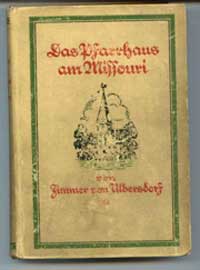
Another significant book by Zimmer von Ulbersdorf was Das Pfarrhaus am Missouri (The Parsonage in Missouri), published in 1914. It may be based on his experiences in DeSoto and Bellefontaine from 1904 to 1909. A copy of this 288-page book is in the collection of the Concordia Historical Institute in St. Louis. Two copies are also available today from a German antique book web site: www.antiquario.de at €8.4 and €11.8.
Wellston, Missouri
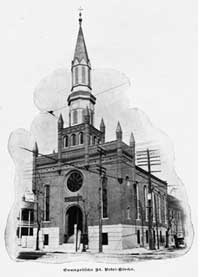
According to the Eden Seminary archives, in 1909, Gustav served a congregation in Wellston, Missouri, where he had previously attended Eden Seminary. There are no UCC churches in Wellston today. But in 1909, one did exist. Die Deutsche Evangelische St. Petri Gemeinde (the German Evangelical St. Peter’s Church), popularly known as “Little Saint Peter’s.” This name differentiated the congregation from its parent church located at 15th and Carr in Old North St. Louis (now St. Peter’s Evangelical UCC, 1425 Stein Road in Ferguson, Missouri). The Eden Seminary archives state that the church he served in Wellston is unknown.
In 1863, as the population of St. Louis expanded to the west, St. Peter’s, a large and prosperous congregation, provided financial support and donated land from its cemetery on Lucas-Hunt Road near Wellston to establish a new congregation to serve the needs of local area residents. The new church was formed in 1869 as Concordia Congregation of Central Township. In appreciation to the generosity of its parent church, the congregation changed its name to St. Peter’s in 1889.
In 1938, the congregation moved to a new building in Normandy, Missouri, and eventually closed in 1980. However, an online list of pastors of St. Peter’s in Normandy did not list Gustav’s name. Wherever Gustav served in 1909, it was for a very brief period, because in the same year he was at a parish in Wisconsin.
parishes in Wisconsin
Gustav Zimmer’s next two parishes were in neighboring towns in Wisconsin. For a time, he served two churches jointly. Gustav was the pastor of Die Deutsche Evangelische Christus Gemeide (the German Evangelical Christ Church) in Cudahy, Wisconsin from 1909 to 1911. He concurrently served at Die Deutsche Evangelische St. Lukas Gemeinde (the German Evangelical St. Lukas Church) in South Milwaukee from 1909 to 1912. The German Evangelical Synod’s Evangelical Year Book for 1912 placed Gustav Zimmer in South Milwaukee, Wisconsin.
The church history of St. Luke’s states:
The Rev. Gustav Zimmer came and served the two churches until 1911 when he gave his resignation to Christ Church and came to serve only St. Lucas Church.
Today this congregation is St. Luke’s United Church of Christ, 2200 18th Avenue, South Milwaukee, WI 53172, (414-762-8260).
At the time, Christ Evangelical Church was located at 4801 S. Packard Avenue in Cudahy. The 1910 federal census shows that the Zimmer family was living at 1105 Packard Avenue in Cudahy. Gustav was listed as a clergyman of the “Evangelical Lutheran Church.” In November 1909, Dorothea Zimmer was born in Cudahy.
Years after Gustav Zimmer left, on November 30th, 1925, the German Evangelical Christ Church sold their property for $5,000 to the People’s State Bank which wanted to build a new structure on their site. The church was moved to a new foundation on a lot at 3559 East Barnard Avenue in Cudahy, with the cost of the lot and foundation provided by the bank. The only nearby congregation that exists today named Christ Church is the Christ Church (Bay View) United Church of Christ in Milwaukee. However, the current pastor has found no record of Gustav Zimmer as a pastor there, so they must not be the same congregation.
the Joint Wisconsin Synod
From South Milwaukee, Gustav moved to Milton, Wisconsin. There he served at Die Evangelisch-Lutherische Sankt Johannes Gemeinde (the Saint Johns Evangelical Lutheran Church) on 910 East High Street, Milton, WI 53563, (608-868-7501). Today, it is a Wisconsin Evangelical Lutheran Synod (WELS) congregation. At the time, it was associated with the Evangelical Lutheran Joint Synod of Wisconsin and Other States, more commonly called the Joint Wisconsin Synod.
In the February 4, 1912 edition of the German Evangelical Synod’s publication, Der Friedensbote (The Messenger of Peace), a notice appeared of Gustav Zimmer’s withdrawal from the Evangelical Synod of North America. At this point, he became associated with the Joint Wisconsin Synod, a predecessor of the Wisconsin Evangelical Lutheran Synod (WELS).
The earliest Wisconsin Synod was founded in 1850 by several churches in and around Milwaukee, Wisconsin as the German Evangelical Ministerium of Wisconsin. Many of the early pastors were educated and trained by mission societies in Germany, and the early churches in the Wisconsin Synod had a strong German background; services and church business were conducted in German.
In 1892, three conservative synods of German background formed a federation called the General Evangelical Lutheran Synod of Wisconsin, Minnesota, Michigan and Other States. In 1904, the Nebraska Synod joined the federation, which then became known as the Joint Synod of Wisconsin, Minnesota, Michigan, and Nebraska. In 1917, the synods were incorporated into one body, and in 1919, the body’s new constitution created the name of the Evangelical Lutheran Joint Synod of Wisconsin and Other States. (The present name of the Wisconsin Evangelical Lutheran Synod was adopted in 1959.)
Kürschners Deutscher Literatur-Kalender
A 1917 Lexicon of German writers and storytellers, Kürschners Deutscher Literatur-Kalender, stated that Gustav Adolf Zimmer was a pastor in Milton, Wisconsin. The lexicon listed these books and publications by Zimmer von Ulbersdorf:
- Der deutsche Feinbäcker (The German Fine Baker), 1896; 2nd edition, 1898
- Die deutsche Einmachekunst (The German Art of Preserving), 1899
- Wie folgt man Jesu nach? (As we follow after Jesus?), 1899
- Siegesklänge (Victory Sounds), 1900
- Founder and publisher: Die Waisenblätter (The Orphan Pages), 1901-1908
- Deutsche Lieder aus dem wilden Westen (German Songs from the Wild West), 1902
- Editor: Das Licht von Utah (The Light of Utah), 1903/1904
- Unter den Mormonen in Utah: Mit besonderer Berucksichtigung der deutschen evangelischen Missionsarbeit, Ein Beitrag zur neuen Missionsgeschichte (Under the Mormons in Utah: With Special Reference to the German Evangelical Mission Work; a Contribution to Modern Mission History), 1908
- Im Schatten von Mormons Tempel, Erzählung (In the Shade of the Mormon Temple, a Story), 1912
- Die treueste Liebe siegt, Erzählung (The Truest Love Conquers, a Story), 1913
- Das Pfarrhaus am Missouri, Erzählung (The Parsonage in Missouri, a Story), 1914
- Die Mormonengefahr (The Mormon Danger), 1915
According to the lexicon, Gustav’s writings covered a variety of genres, including cooking, theology, poetry, Christian stories, juvenile books and anti-Mormon tracts.
Gustav Zimmer was very interested in the natural world. Another book by Zimmer von Ulbersdorf reflected on his years in Wisconsin, Fern Aus Wisconsin Auf Der Hickoryfarm, Erzählungen (Far from Wisconsin on the Hickory Farm, Stories) was published in 1924 by Buch und Kunstverlag, Carl Hirsch A. G., Konstanz (Book and Fine-Art Publishing House, Carl Hirsch A.G., Constance). Konstanz (or Constance) is a university town of around 80,000 inhabitants at the western end of Lake Constance in the southwest corner of Germany, bordering Switzerland.
parishes in Ontario
On December 14, 1917, a Canadian border crossing record at Windsor, Ontario lists Gustav (48), Anna (49), Johanna (14), Bertha (12), Lothar (9), Dora (8) and Dankwart (6) departing from Wisconsin and traveling to Rankin, Ontario. Gustav’s profession was listed as “Lutheran pastor.” The entry listing all the family members was divided over two pages. On the first page it said they were traveling by CPR (Canadian Pacific Railway), and on the second it said they crossed the Detroit River by ferry. Perhaps they boarded the CPR after they took the ferry to Windsor from Detroit.
From about 1917 to 1920, Gustav moved his family to Ontario where according to his obituary he served congregations in Rankin, Walton, and Bonnechere. Rankin is just east of Sault Sainte Marie in Michigan’s Upper Peninsula, Walton is about 75 miles north of London, Ontario and Bonnechere is about 25 miles west of Pembroke. There are no Wisconsin Synod churches in these towns today, but there are congregations of the Evangelical Lutheran Church in Canada (ELCIC).
There are no Lutheran church listings at all for Rankin, Ontario. However, in nearby Sault Ste. Marie, Zion Evangelical Lutheran Church was founded as an English-speaking congregation in 1922. They mention on their web site that a German-speaking congregation, St. Mark’s, disbanded in 1970 and many members then joined Zion. Information may be available at Zion Evangelical Lutheran Church (ELCIC), 189 Upton Road, Sault Ste. Marie, ON P6A 3W5 Canada (705-253-8703) (Rev. Jouko Jyrkama – pastorj@shaw.ca). To date, none has been received.
Walto, Ontario doesn’t exist as far as I can discover, and had I assumed the obituary dropped the letter “n” in “Walton.” No Lutheran churches are located in Walton, Ontario today. However, there is a small Lutheran congregation in Wiarton, Ontario in the Bruce Peninsula, founded in 1887. St. Peter’s Lutheran Church (ELCIC), 441 Brown Street, PO Box 608, Wiarton ON N0H 2T0 Canada, (519-534-3456). (Rev. Brad Mittleholtz – bradtracy@bmts.com). No confirmation of Gustav Zimmer’s service there has been received.
In Bonnechere, Ontario, St. John’s Evangelical Lutheran Church at 2291 Lake Dore Road is associated with the Evangelical Lutheran Church in Canada (ELCIC). The congregation was formed in 1863. St. John’s Evangelical Lutheran Church, PO Box 41, Eganville, ON K0J 1T0 Canada (613-625-2337). (Rev. Charles Nolting, no email address, office phone: 613-625-9931). I have not yet contacted this church.
I have found no U.S. census record for the family for 1920, so they may have been in Ontario at that point. However, the 1921 Lutheran Almanac in the archives of the Concordia Historical Institute places Rev. Gustav Adolf Zimmer at the parish in Milton, Wisconsin in that year. (This is the earliest Lutheran church almanac in their collection, so previous locations for Gustav are not available from this source.) The listing has the abbreviation “SWis” next to Gustav’s name, indicating membership in the Joint Wisconsin Synod.
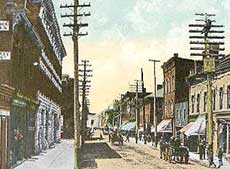
Near the end of 1920, due to his wife’s failing health, Gustav resigned his parish in Bonnecher and moved his family to Pembroke, Ontario.
A possible congregation in Pembroke is Zion Evangelical Lutheran Church (ELCIC), first organized in 1883. Until 1921, all regular services were conducted in German. Zion Evangelical Lutheran Church is located at 454 Miller Street, Pembroke, ON K8A 5Z4 Canada, (613-732-8792). (Two pastors are on the staff: Rev. Martin Malina – pastormartin@zionlutheran.ca, and Rev. Svante Olson – pastorsvante@zionlutheran.ca)
death of Anna Zimmer
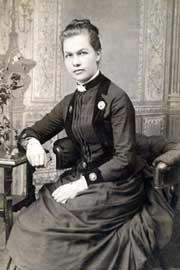
On July 8, 1921, Anna Augusta Zimmer died at age 52 in Pembroke. The cause of death was tuberculosis of the peritoneum. Tuberculosis is caused by a bacteria that is spread through the air by infected people who cough, sneeze, or spit. It most commonly affects the lungs, but infections can occur in many other bodily organs, including the gastrointestinal tract. Anna’s death certificate said that she had suffered from the condition for ten months. In the end, a contributing factor in her death was emesis, or vomiting.
Anna Zimmer left behind five children: Johanna (19), Bertha (17), Lothar (Paul) (14), Dorothea (Dorothy) (13), and Dankwardt (D. William) (11).
The 1922 Lutheran Almanac lists Rev. G. A. Zimmer serving a congregation in Pembroke, Ontario Canada. Again, the listing has the abbreviation “SWis”, indicating membership in the Joint Wisconsin Synod.
return to Wisconsin
Around this time, Gustav returned to Wisconsin, moving to the town of Schofield. He served at St. Peter Evangelical Lutheran Church (WELS), 1351 Grand Avenue, Schofield, WI 54476 from 1921 to 1923. A church history states that when he left the congregation, a post-World War I economic recession forced St. Peter to join with two other congregations in a tri-parish arrangement. St. Peter Lutheran Church in Schofield, Salem Lutheran Church in Wausau, and Grace Lutheran Church in Ringle were then served by a single pastor.
Gustav Zimmer eventually became a chiropractor/osteopath. How early he began these studies and where he studied is not entirely clear. But it was obviously an overlap with his career in ministry.
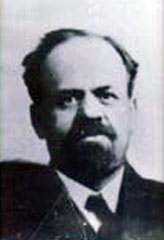
In 1923, Gustav was called to St. Peter Lutheran Church in Brodhead, Wisconsin, where he retired in 1925. Today, the congregation is St. Peter Lutheran Church (WELS), 17th Street & West 5th Avenue, Brodhead, WI 53520, (608-897-2092).
By the time he served in Brodhead, Gustav Zimmer was already a licensed chiropractor. There was some objection in the congregation to his pursuit of both careers simultaneously.
Church records also show that at one point Dankwardt (D. William) Zimmer was employed as the church janitor and paid 50 cents a week.
remarriage
Gustav remarried in 1925 at age 55. His bride, Auguste Hedwig Franke, and had been a childhood sweetheart in Germany before he left the country. She sailed from Bremen to New York City on the Republic, on December 8, 1925. She was a 52-year-old milliner from Limbach, the town in Germany that Gustav had departed from 25 years earlier. Her destination was “Broadhead,” Wisconsin. The ship’s manifest lists her father as Richard Bachman, so perhaps that was her maiden name. Hedwig and Gustav married on December 22, 1925.
Doctor of Chiropractic/Osteopathy
Gustav returned to Pembroke, Ontario and set up a chiropractic practice there. He took only his youngest child—Dankwardt (D. William)—with him, initially to live in Canada, and later to live in Germany.
A January 4, 1927 Canadian border crossing manifest lists Gustav’s occupation as an “osteopath” and states that he maintained an office in the Fraser Block of Pembroke, Ontario. Gustav (57) had been visiting his daughter J. (Johanna) Zimmer in Madison, Wisconsin with his son Dankwart (15). He returned to Canada on the Canadian National Railway via Sarnia, Ontario.
Several weeks later, on January 29, 1927, Johanna Zimmer married Herbert Carl John Schumacher in Edgerton, Wisconsin.
return to Germany
In 1927, Gustav returned to Germany to establish a chiropractic clinic in Fraustadt, Provinz Grenzmark-Pozen-Westpreußen. The province of Grenzmark-Pozen-Westpreußen existed from 1920 until 1938 consisting of sections of the former Prussian province of Posen that had not been turned over to Poland after World War I as a result of the Treaty of Versailles. It was dissolved in October 1938, and the area was divided between the neighboring provinces Brandenburg, Schlesien, and Pommern. Fraustadt went to Schlesien.
Fraustadt was about 15 miles northwest of Gustav’s birthplace of Kraschen, and only about six miles from the border with Silesia. Fraustadt was originally the Polish town of Wschowa. Within the Second Partition of Poland in 1793, Wschowa was annexed by the Kingdom of Prussia. In 1945, at the end of World War II, the Potsdam Conference ceded additional territory to Poland. Today, Fraustadt is once again the town of Wschowa. It is the capital of Wschowa County in the Lubusz Voivodeship on the western border of Poland.
In May 1927, Gustav Zimmer borrowed $200 from his nephew Arthur Sagner who was working as a bank employee in Saint Louis, Missouri. (See Gustav Sagner and Eleanora Girthofer.) The money may have been needed to help pay for his daughter Dorothea’s nurses training.
In 1927, Gustav moved to Dresden, Germany where he established an extensive practice and founded the Ausbildungsstätte für Chiropraktik (Training Center for Chiropractic). Pupils came from all countries of Europe.
the Zimmer children
The 1930 census shows Johanna and Herbert living on High Street in Milton, Wisconsin. Bertha Zimmer lived with them and was a registered nurse in private practice. Herbert’s occupation was a minister in the Lutheran church. He was most likely the new pastor at Saint Johns Evangelical Lutheran Church on 910 East High Street, which he served for 42 years.
Eventually, Johanna, Bertha and Dorothy all became registered nurses.
On February 24, 1930, Lothar (Paul) Zimmer married Winona Josephine Adams in San Fernando, California. The April 1930 census had listed him as a milkman and a lodger on a dairy farm in Los Angeles.
On February 24, 1931, Dankwardt (D. William) Zimmer (20) arrived in New York from Bremen, Germany. His U.S. address was listed as c/o Rev. W. Schuhmacher in Milton, Wisconsin. This must be a reference to Rev. Herbert Schumacher. (Did Dankwardt leave his father permanently at this point?)
chiropractic study and writing
In 1933, Gustav Adolf Zimmer published the second edition of Der kürzeste Weg zur Gesundheit: Die chiropraktische Heilkunst!: Die einfach-verstandesgemässe Art ihrer Anwendg, ihre wunderbaren Heilerfolge U. Weltweite Verbreitg; frei nach d. Amerik. (The Shortest Way to Health: The Holistic Chiropractic Art!: The simple understandably appropriate nature of its application, its marvelous sound sequence, and world-wide dissemination; freely after the Americans.) It was published by the Bund für Chiropraktik und Osteopathie (the Federation for Chiropractic and Osteopathy).
The library of the Swiss Chiropractic Academy in Bern, Switzerland lists another book by Gustav Adolf Zimmer von Ulbersdorf in its library. It is titled Chiropraktik oder das menschliche Rückgrat als Träger und Ursache von Gesundheit und Krankheit (Chiropractic, or the Human Spine as Carrier and a Source of Health and Disease). This was published in 1934.
On June 16, 1934, Gustav (64) sailed on the Columbus from Bremen to New York, arriving on June 24, 1934. He had a U.S. passport issued in Dresden on June 7, 1933 and his residence in the U.S. was listed as “Highstreet” in Milton, Wisconsin. At this point, Gustav was living in Nazi Germany.
While in the U.S., Gustav attended post-graduate courses at leading chiropractic schools. According to his obituary, on returning to Germany, he published the first German book on chiropractic and drugless therapy. (However, he had already published titles in 1933 and 1934 on chiropractics.)
In 1935, he published Chiropraktik, ihre Anwendung und Ausführung: Ein Leit f. und Nachschlagebuch für Chiropraktik; nach der Besten Amerikanischen Quellen wie auf Grund eigener Erfahrg (Chiropractic, its application and implementation: a guidance and reference book for chiropractors; after the best American sources from personal experience).
That same year, Gustav published Was Jeder Kranke über Chiropraktik Wissen Muss!: Eine aufklärg und beitrag zu Deutschen volksgesundheit (What Each Patient Must Know About Chiropractic!: a solution and contribution to German public health). It was published by Hedwig Zimmer Publishing for “Chiropractic and Medicine-free Ways.” Gustav Zimmer’s second wife Hedwig was the publisher of his and other chiropractic writings in Germany
Another book which may have been an updated version of the same was simply titled Chiropraktik. It was published posthumously in 1951 and carries the names of August M. Dickmann and Gustav Adolf Zimmer as the authors. It ran 259 pages.
In 1936, Gustav’s daughters Bertha and Dorothy traveled to Germany to visit their father.
retirement and death
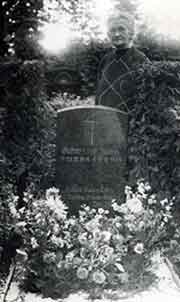
Gustav finally retired due to ill health and overwork in May of 1938. He had planned to return to the United States and make his home in California, but he was too ill to do so. He moved to the town of Limbach inFreistaat Sachsen (Free State of Saxony). This had been his last residence before emigrating to the United States in 1900. He returned there 38 years later.
In the following year, German troops invaded Poland on September 1, 1939, precipitating World War II.
Three of Gustav Zimmer’s published books were placed on the “list of harmful and undesirable literature” and were banned by the Nazis.
Gustav Adolf Zimmer died at age 69 at 7:30 AM on December 17, 1939 in the town of Limbach, Freistaat Sachsen (Saxony), Deutsches Reich (German Empire).
1940 – 1949
1941 was a big year for weddings in the family. Dankwardt (D. William) Zimmer married Gertrude Loretta Hansen on May 10, 1941 in Van Nuys, California. Bertha Zimmer married Tweet Webb on December 19, 1941 in Yuma, Arizona. Just six days later, Dorothea (Dorothy) Zimmer married Olen Bertus Welch on Christmas Day, December 25, 1941 in California.
a bibliography of known works by Gustav Adolf Zimmer von Ulbersdorf
- Der deutsche Feinbäcker (The German Fine Baker), 1896; 2nd edition, 1898
- Die deutsche Einmachekunst (The German Art of Preserving), 1899
- Wie folgt man Jesu nach? (As follows one Jesus after?), 1899
- Siegesklänge (Victory Sounds), 1900
- Founder and publisher: Die Waisenblätter (The Orphan Pages), 1901-1908
- Deutsche Lieder aus dem wilden Westen (German Songs from the Wild West), 1902
- Editor: Das Licht von Utah (The Light of Utah), 1903/1904
- Unter den Mormonen in Utah: Mit besonderer Berucksichtigung der deutschen evangelischen Missionsarbeit, Ein Beitrag zur neuen Missionsgeschichte (Under the Mormons in Utah: With Special Reference to the German Evangelical Mission Work; a Contribution to Modern Mission History), 1908
- Im Schatten von Mormons Tempel, Erzählung (In the Shade of the Mormon Temple, Narration), 1912
- Die treueste Liebe siegt, Erzählung (The Truest Love Conquers, a Story), 1913
- Das Pfarrhaus am Missouri, Erzählung (The Parsonage in Missouri, a Story), 1914
- Die Mormonengefahr (The Mormon Danger), 1915
- Fern in Wisconsin : Auf der Hickoryfarm : Zwei Erzählungen (Far from Wisconsin on the Hickory Farm, Stories), 1924
- Der kürzeste Weg zur Gesundheit: Die chiropraktische Heilkunst!: Die einfach-verstandesgemässe Art ihrer Anwendg, ihre wunderbaren Heilerfolge U. Weltweite Verbreitg; frei nach d. Amerik. (The Shortest Way to Health: The Chiropractic Healing Art!: The Simple Understandable Nature of its Application, its Miraculous Cures, and World-wide Dissemination; Freely from American Sources), 1933
- Chiropraktik oder das menschliche Rückgrat als Träger und Ursache von Gesundheit und Krankheit (Chiropractic or the Human Backbone as Carrier and a Cause of Health and Illness), 1934.
- Was Jeder Kranke über Chiropraktik Wissen Muss!: Eine aufklärg und beitrag zu Deutschen volksgesundheit (What Each Patient Must Know About Chiropractic!: a solution and contribution to German public health), 1935
- Chiropraktik, ihre Anwendung und Ausführung: Ein Leit f. und Nachschlagebuch für Chiropraktik; nach der Besten Amerikanischen Quellen wie auf Grund eigener Erfahrg (Chiropractic, its application and implementation: a guidance and reference book for chiropractors; after the best American sources from personal experience), 1935
- Chiropraktik, August M. Dickmann and Gustav Adolf Zimmer, 1951
- Der Bäcker Gustel (The Baker Gustel), 2003